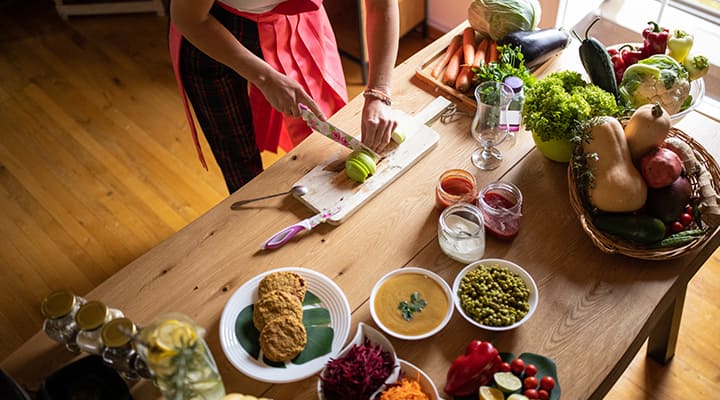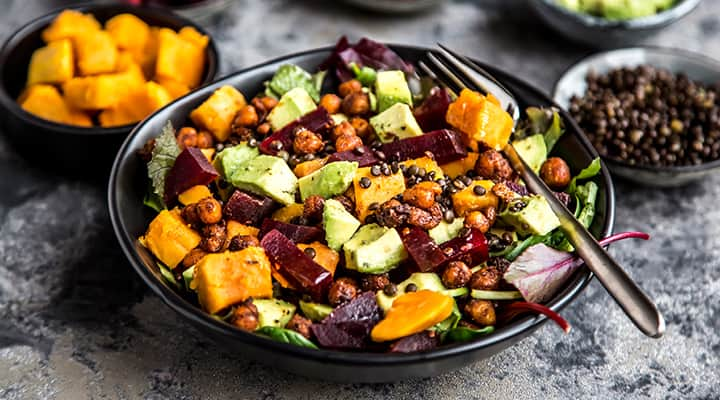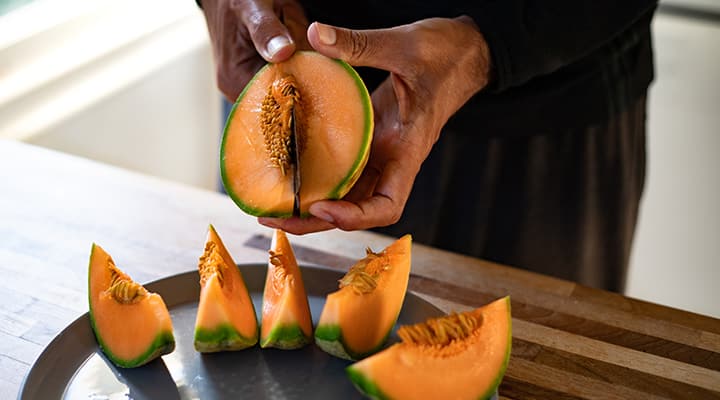
12 High-Potassium Foods to Add to Your Diet
Published: August 2022
You might not be thinking about potassium every time you sit down for a meal, but with a recommended serving of 4,700 mg per day, this essential mineral does deserve a place on your plate—particularly if you’re concerned about maintaining healthy blood pressure. Potassium supplements in capsule or tablet form only contain up to 99 mg per the Food and Drug Administration, so you won’t be able to lean heavily on supplements for support; instead, dietary potassium is going to need to do the heavy lifting when it comes to meeting your daily goals.
Luckily, your grocery store is bursting with fresh produce that is packed with potassium—you just need to know where to look! Here is a complete breakdown of the best potassium-rich foods to incorporate into your daily meals.
What is potassium?
Potassium is a critically important mineral for all of your body's cells, tissues, and organs. This essential mineral plays a primary role in maintaining normal water and fluid balance throughout your body. Within your body, potassium is an electrolyte, meaning it helps regulate muscle contractions, heart health, kidney function and nerve signals. In fact, every cell in your body requires adequate levels of potassium to function properly.
Our bodies can’t produce potassium (or any other mineral, for that matter), so it is imperative to eat a well-balanced diet that is rich in this essential mineral. Many nutrient-rich foods are an excellent source of dietary potassium, including fruits, vegetables, nuts, beans, dairy, meats, poultry and fish. However, some foods are more concentrated in this mineral than others, so before you fill up your plate, you’ll want to understand which foods will yield the highest milligrams per serving of potassium.
On a Low Sodium Diet? You Probably Need More Potassium!
Forget yin and yang—potassium levels and sodium levels are intricately connected, and maintaining a healthy sodium-to-potassium ratio is key to help keep your blood pressure healthy. Many people opt for a low-sodium diet—but did you know you’ll get more “bang for your buck” from cutting back on salt if you also add more potassium-rich foods? A diet rich in potassium is almost always recommended for people keeping an eye on their salt intake.
What foods are the highest sources of potassium?
If you walk into your local grocery store, you may notice that there is no signage leading you to potassium-rich foods. However, with a little know-how, you’ll soon become a pro at spotting foods rich in this essential mineral and will be able to navigate yourself to delicious foods with the highest potassium content. Pro tip: Your first stop on your grocery store trip should be to the produce section, which is a treasure trove of potassium-rich fruits and vegetables.
While meat, dairy, juices, cooked beans and even seafood all offer their fair share of potassium, you’ll get the most potassium from root vegetables like yams and potatoes, dark leafy greens and squash, while also incorporating plenty of fruits like oranges, avocados, bananas, plums and cantaloupe.
12 High Potassium Foods
Each of these grocery store staples is a good source of potassium–and offers other health benefits, too!
1. Prunes
While everyone may not be a fan of dried plums (AKA prunes), ask grandma or grandpa why they love this magical fruit and they’ll make you a fan, too. Famously, prunes are packed with fiber that helps aid in digestion. They are also a low sodium food, packed with potassium—1,274 milligrams of potassium per one cup, to be exact! Additionally, prunes contain vitamins A, K, B6, and iron.
Still not sold on the power (or taste) of prunes? You can always opt for their non-dried counterpart, plums. Although not as impressive as prunes in terms of potassium levels, each fresh plum still offers 104 milligrams of this essential mineral as well as the same vitamins and minerals you’d get from snacking on some prunes.
And if you really can’t bring yourself to eat any form of the prune, but are OK with other types of dried fruit, all is not lost. Dried apricots, raisins, dried peaches, figs and dates are also good sources of potassium—just watch serving sizes because, like prunes, they’re also higher in sugar and calories per serving compared to fresh or frozen fruit.
2. Lima beans
You might not see lima beans on the menu at that posh new neighborhood bistro, but don’t overlook this humble legume, which packs in a whopping 927 mg of potassium per one-cup cooked serving! Try lima beans mixed in chili, tossed with a salad, or pureed into a hummus. If you’re not a lover of lima beans, white beans, adzuki beans and kidney beans are good sources of potassium as well.
3. Yams and potatoes
These tasty root vegetables are not only a great side dish for just about any meal, but are also high in potassium while low in sodium. In fact, one cup of cooked yams provides your body with 911 mg of potassium. These amber-hued taters also are a good source of fiber, which helps you keep full longer. Another benefit—yams are bursting in beta-carotene, the vegetarian form of vitamin A.
However, if yams aren’t your jam, yet you still yearn for a spud with health benefits, you can opt for a baked potato instead. (We love russets, but any variety will do!) One medium baked potato (without toppings like cheese or sour cream) provides 926 mg of potassium per serving.
Recipe suggestion: Sweet potatoes (not to be confused with yams) are another great source of potassium, and happen to be the starring ingredient of this vegan potato salad!
4. Bananas
Perhaps the fruit most likely to come to mind when you think of potassium-rich foods, bananas may be a bit overhyped as a source of this essential mineral. Contrary to popular opinion, bananas aren’t exactly as chock full of potassium as other items on this list, offering about 422 mg of potassium per medium-sized fruit. Nevertheless, they still boast big health benefits.
Having a banana in your breakfast or daily snack supports overall heart health as well as healthy blood pressure levels, because it provides a healthy dose of potassium with extremely little sodium.
Recipe suggestion: Slow-cooker banana bread is the perfect start to your morning!
5. Avocados
If you need another reason to order guacamole at your favorite Mexican restaurant, here’s one (or several) that will get you hooked on all the health benefits of this tropical fruit. Avocados are packed with healthy fats, vitamin K, folate and potassium. Slice up a whole avocado, and you’re looking at a hefty 690 mg of potassium, which is nearly 15% of your daily value (DV) of potassium in one sitting. Avocados to bananas, a whole avocado beats out everyone’s favorite yellow fruit in terms of potassium content—holy guacamole!
Besides tasting delicious, avocados are rich in fiber and low in sodium, a healthy-healthy combination! Spread avocado on toast as a cardio-friendly alternative to butter or cheese.
Recipe suggestion: Try these 4 avocado lunchbox ideas for a tasty, portable, potassium-rich lunch!
6. Beet greens
There’s no denying it: you can’t beat the health benefits of beet greens! Not to be confused with the ruby-red root vegetable that’s on the other end of the stalk, those edible, emerald green leaves are an excellent way to add some texture and flavor to an ordinary salad—not to mention a terrific source of potassium! Get creative in the kitchen with beet greens by cooking, boiling or juicing them, and you’ll be rewarded with 654 milligrams of potassium per each half cup serving.
Pro tip: enjoy the entire beet plant to get big health benefits like supporting healthy blood pressure, blood vessel function, and antioxidant protection.
Recipe suggestion: Try this tasty beet detox juice!
Explore Our Best Heart Health Supplements
7. Leafy greens
Beet greens aren’t the only way to get potassium from your salad bowl, however. Other leafy greens including Swiss chard and spinach are among the most potassium-rich foods around. Plus, these nutritional superstars are also packed with vitamins, other minerals, and an array of phytonutrients.
Spinach wasn’t Popeye’s favorite leafy green vegetable for nothin’! High in vitamins, spinach is packed with potassium—419 mg in half a cup when cooked. Incorporating spinach into your meals also helps support eye health and healthy blood pressure, while protecting against oxidative stress. So whether you enjoy spinach into your next salad, smoothie or sauté, you’ll receive 9% of your daily value of this essential mineral.
If spinach isn’t your go-to green, give Swiss chard a try. Dark, leafy and brimming with benefits, Swiss chard contains an impressive nutritional profile for your dietary requirements. In fact, Swiss chard contains vitamins A, K, C and E as well as copper, magnesium, fiber—and of course, potassium. Consuming Swiss chard helps support healthy blood pressure levels and weight management as this vegetable is packed with fiber (which helps you feel fuller for longer.)
Recipe suggestion: Go green with this spinach-rich Tropical Green Smoothie.
8. Lentils
Brown, green, black, red or yellow are just a few of the different varieties of lentils you can incorporate into your diet. Lentils are small, round legumes that are not only rich in fiber and folate, but also have decent levels of potassium, making them a great option for those looking to support healthy blood sugar and cholesterol levels.
Lentils also make an appetizing addition to soups or stews, but it is always best to incorporate dried lentils into your diet as canned lentils may contain excess sodium.
Recipe suggestion: Warm up a bowl of vegan lentil soup.
9. Cantaloupe
Poor cantaloupe often gets snubbed in fruit salads and isn’t exactly top of mind when you are hankering for some fresh fruit. However, once you know all the potassium content and other nutritional benefits it has to offer, you might just give this magical melon a second glance.
An entire medium-sized cantaloupe contains 1,474 mg of potassium; eating a half or even a quarter at breakfast offers a potassium-packed start to your day! Cantaloupes also provide beta-carotene, vitamin C, folate, fiber as well as other vitamins and minerals like magnesium, zinc, copper, selenium and more! This melon is also made of 90% water, making it the perfect fruit to keep you hydrated on a hot summer’s day (or any day for that matter).
10. Acorn squash
When it comes to seasonal fall veggies, there’s one that squashes the competition—acorn squash. This nutty-flavored vegetable is packed with antioxidants, magnesium, fiber, vitamin C, folate and 19% DV of potassium per cooked cup. Certainly, acorn squash deserves a seat at the table at your next gathering—baked, pureed in a soup, or added to a smoothie.
To be fair, acorn squash isn’t the only good-for-you gourd. Butternut squash is another potassium-rich fall and winter specialty, and cooked pumpkin delivers a nice amount of potassium while being naturally low in sodium.
Recipe suggestion: This roasted vegetable salad stars potassium-rich butternut squash, yams and avocado—plus, it’s delicious!
11. Orange juice
You may think of orange juice as the king (or queen) of vitamin C; however, its potassium content often gets overlooked. A single cup of orange juice provides 496 milligrams of potassium as well as folate, vitamins A and C, thiamine, and antioxidants. Other fruit and vegetable juices, including pomegranate, tomato, passion fruit and carrot juice, also offer good potassium content.
Pro tip: While juices might pack in the potassium, they also have a naturally high sugar content, and should be enjoyed in moderation. For your body to reap the benefits from the vitamins and minerals oranges and other fruits have to offer, it is always best to eat the fruit fresh. If you do have a craving for O.J., squeeze it yourself—or better yet, use a juicing machine that makes use of all parts of the fruit. At the bare minimum, look for a store-bought brand that is 100% juice without added sugars.
Recipe suggestion: Cheers to a tasty way to enjoy potassium-rich orange juice—whip up this summer sangria!
12. Plain yogurt
It’s plain to see that plain yogurt is a great source of potassium; a one-cup serving contains 531 mg of potassium of this essential mineral (not to mention being a good way to increase your protein and calcium intake). True, plain yogurt on its own isn’t the most “exciting” food in the taste and texture department, but it happens to be the perfect blank canvas for other tasty, potassium-packed vittles! Enjoy it with fresh fruit and a few raisins sprinkled in. Plain yogurt also lends itself to being a smoothie ingredient and can even be used as a base for salad dressing.
Pro tip: If you want to get really creative, create your own potassium smoothie extravaganza with plain non-fat yogurt, avocado, and bananas!
Why do you crave potassium rich foods?
If you’re craving foods that are rich in potassium, your body may be trying to tell you something. So by all means, slice up a banana, eat that salad, or enjoy some fresh guacamole with raw vegetables!
More often than not, though, specific food cravings are not for potassium specifically, but foods that are salty or sweet—and often are high in fat and calories.
There’s no reason why you can’t use these cravings as an opportunity to hit your potassium goals, however. For example, if you’re craving sweets, a banana may satisfy that urge while also nourishing you with potassium. And a baked potato or acorn squash can give you the carby goodness of fries or chips—without the added salt or fat.
Are supplements enough to cover potassium deficiencies?
You should eat a diet rich in potassium. Incorporating a high-quality potassium supplement into your wellness routine might can fill in the gaps where your diet falls short.
Pro-tip: Potassium and magnesium are complementary heart-healthy nutrients. The best kind of potassium supplement will combine magnesium and potassium in one formula to support healthy blood pressure levels, blood flow, and cardiovascular health.
Make sure to speak with your primary care physician prior to incorporating any new supplements into your wellness routine.
References
- Challa HJ, et al. “DASH Diet To Stop Hypertension.” NIH. May 2022. https://www.ncbi.nlm.nih.gov/books/NBK482514/
- Ganesan K, Xu B. “Polyphenol-Rich Lentils and Their Health Promoting Effects.” Int J Mol Sci. November 2017. https://www.ncbi.nlm.nih.gov/pmc/articles/PMC5713359/
- D'Elia L, et al. “Potassium intake, stroke, and cardiovascular disease a meta-analysis of prospective studies.” J Am Coll Cardiol. March 2011. https://pubmed.ncbi.nlm.nih.gov/21371638/
- Jajja A, et al. “Beetroot supplementation lowers daily systolic blood pressure in older, overweight subjects.” Nutr Res. October 2014. https://pubmed.ncbi.nlm.nih.gov/25294299/
- Jovanovski E, et al. “Effect of Spinach, a High Dietary Nitrate Source, on Arterial Stiffness and Related Hemodynamic Measures: A Randomized, Controlled Trial in Healthy Adults.” Clin Nutr Res. July 2015. https://www.ncbi.nlm.nih.gov/pmc/articles/PMC4525132/
- Pereira-Caro G, et al. “Orange juice (poly)phenols are highly bioavailable in humans.” Am J Clin Nutr. November 2014. https://pubmed.ncbi.nlm.nih.gov/25332336/
- Tang G. “Chapter 25 – Spinach and Carrots: Vitamin A and Health.” Bioactive Foods in Promoting Health. https://www.sciencedirect.com/science/article/pii/B9780123746283000256
- Venkataraman A, et al. “Variable responses of human microbiomes to dietary supplementation with resistant starch.” Microbiome. June 2016. https://pubmed.ncbi.nlm.nih.gov/27357127/
- “Avocados, raw, California.” FoodData Central. https://fdc.nal.usda.gov/fdc-app.html#/food-details/171706/nutrients
- “Beets, cooked, boiled, drained.” FoodData Central. https://fdc.nal.usda.gov/fdc-app.html#/food-details/169146/nutrients
- “Food Sources of Potassium.” Current Dietary Guidelines. https://www.dietaryguidelines.gov/food-sources-potassium
- “Phytonutrients.” https://www.nutrition.gov/topics/whats-food/phytonutrients
- “Potassium.” Dietary Supplement Fact Sheets. https://ods.od.nih.gov/factsheets/Potassium-HealthProfessional/
- “Squash, winter, acorn, cooked, baked, without salt.” FoodData Central. https://fdc.nal.usda.gov/fdc-app.html#/food-details/169293/nutrients
Like what you read?
Please subscribe to get email updates on this blog.








